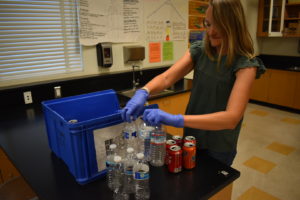Getting Students Outside with Five Steps to Reduce Plastic Use

To view the photo-rich magazine version, click here.
Originally appears in the Winter 2021 issue.
By Lindsey Maheu
The issue of plastic production, consumption, and waste is a growing global concern and for a good reason. Approximately 350 million tons of plastic are produced annually and only 9% are recycled globally[1][2]. People rely heavily on plastics because they are lightweight, durable, inexpensive, and many of the products we buy and use every day are made of plastic[3]. Many plastics, such as straws, cannot be recycled, and the ones that can become secondary plastics. Secondary plastics can no longer be recycled after one use, and end up in landfills or as pollution in the environment[4]. Plastics degrade through heat and radiation into microplastics (fragments of plastic that are less than 5 mm), and integrate into the soil and water of environments[5]. Humans and all other life forms that rely on soil and water are at risk of consuming plastics, which threatens the health, survival, and sustainability of the environment[2].
With all these problems, what is the solution? Plastic waste needs to be addressed at the community level[6]. The adoption of education and outreach programs starts in communities and creates action by addressing habits, behaviors, and perceptions regarding plastic consumption[2][7]. As a high school science teacher and environmental activist in my community, my goal was to find the most effective strategies for creating community action in eliminating plastic waste. I have been involved in both school-based and non-profit-based conservation projects and was curious as to which types of strategies in each organization had the highest potential for community change in reducing plastic consumption. I researched techniques that represent a diversity of locations around the world and rang in age levels for both school-based and non-profit projects. I also examined community changes based on four categories: attitude towards goals, pro-environmental behavior changes, environmental knowledge, and involvement in the project. The communities with the most effective strategies experienced positive changes when projects encompassed parts from all four categories.
This content is restricted to subscribers only.
If you are not yet a subscriber, please consider taking out a subscription here.
If you are an existing subscriber, kindly log in or contact us at info@greenteacher.com for more information.










